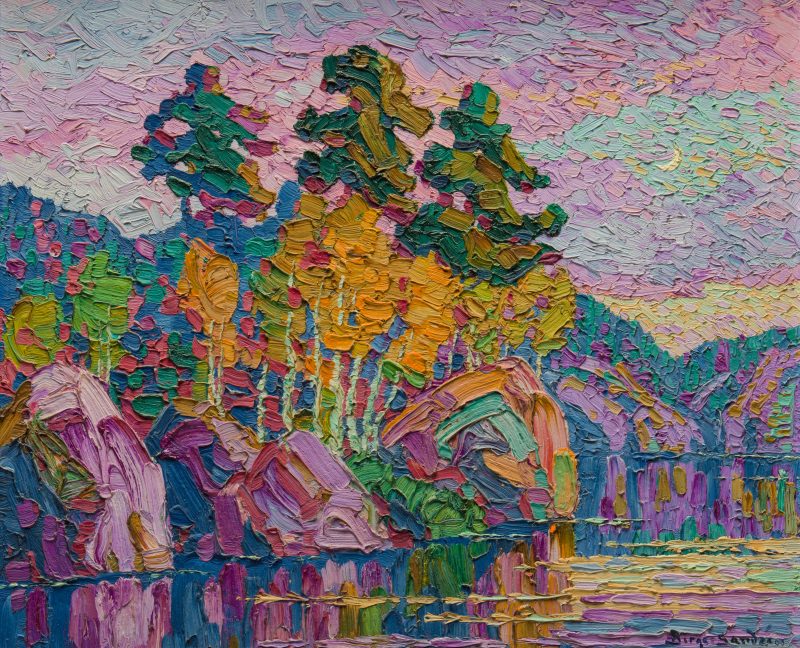 |
|
Birger Sandzen (Colorado/Kansas/Sweden, 1871-1954) oil on board painting, Colorado Landscape, depicting a lake with rocky, tree-lined bank at sunrise or sunset. Mountains are visible in the background, and a crescent moon shines in the pink sky overhead. Signed lower right. 19 1/2″ x 23 1/2″ sight, 28″ x 32″ in carved, whitewashed frame. Accompanied by a 1983 letter from the Birger Sandzen Memorial Gallery attributing the work to Sandzen circa 1928-1931. According to the letter’s writer, co-director Larry Griffis, “The colors and brush strokes are characteristic of the period of his life that produced his finest work.” Griffis compares this work to two other known Sandzen works, “Silent Lake” and “Lake in the Rockies.” Provenance: the estate of Mr. and Mrs. Jeter Eason of Memphis, by descent to present consignor. |
 |
|
John Frederick Kensett (New York, Connecticut/1816 – 1872) “Early Autumn” oil on board, depicting Contentment Island on Long Island Sound, near Darien, Connecticut. This work has been recently added to the John Frederick Kensett Catalogue Raisonne. It was exhibited in the National Academy of Design’s Kensett Memorial Exhibition in 1873 and was documented in a photographic album chronicling the exhibit. Sight – 13 1/2″ H x 17 3/8″ W. Framed – 20 1/8″ H x 24 1/8″ W. Estate of Dr. Benjamin H. Caldwell, Nashville, TN. More information in the coming weeks. |
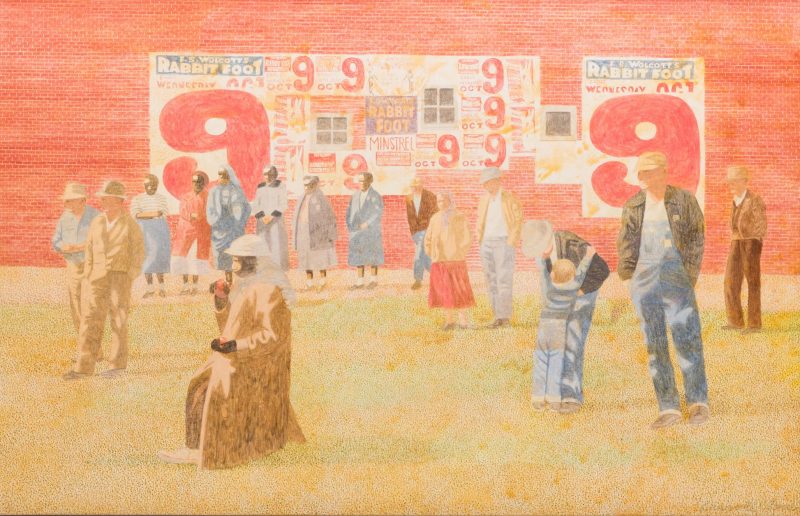 |
|
Carroll Cloar (Tennessee, 1913-1993) acrylic on board painting titled “The Waiting, ” together with a pencil study for the work and exhibition poster. The painting depicts figures standing in a yellow grassy field with red brick building in the background, plastered with posters advertising FS Chapell’s ” The Rabbit’s Foot Minstrel Show.” A seated figure in the foreground wears a beekeeper’s head gear and suit, and eats an apple. Signed lower right “Carroll Cloar”. Titled, signed and dated “1-83″ en verso, along with a New York Forum Gallery label. Silver-gilt molded frame. 23″ H x 34″ W. .Sight – 22″ H x 33 1/8″ W. Framed – 29″ H x 40 1/2” W. Note: This painting was exhibited and used as the catalog cover image for “Carroll Cloar: Timeless Tales of the South,” hosted by Belmont University May 22-July 13, 2003. This lot includes an exhibition poster, along with the original pencil study for the painting, signed and dated by the artist. Estate of Dr. Benjamin H. Caldwell, Nashville, TN. |
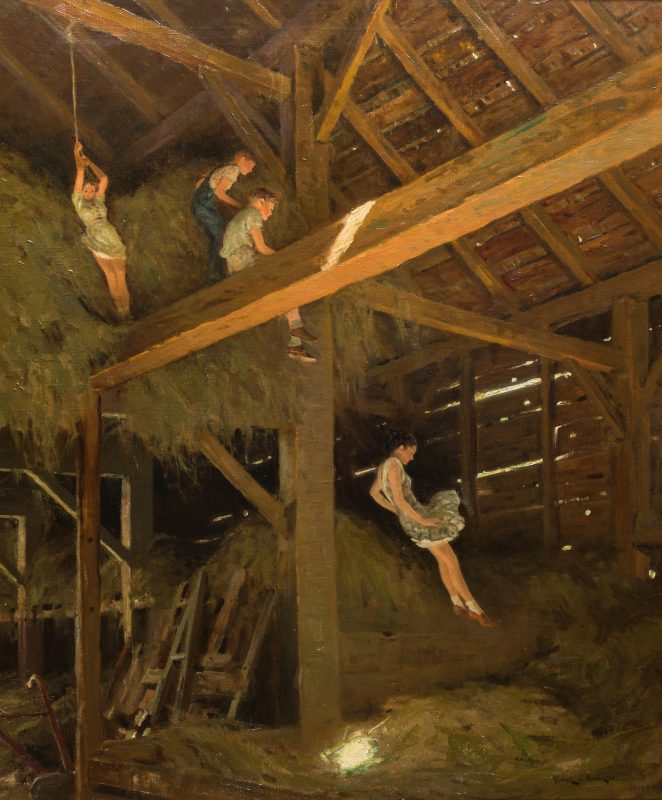 |
|
Victor Anderson (Texas/New York, 1882-1937) oil on canvas titled, “Children Playing in Hay Loft” accompanied by three pencil studies for this work. 30″ x 25″. Circa 1925. Chattanooga, TN collection. More information in the coming weeks. |
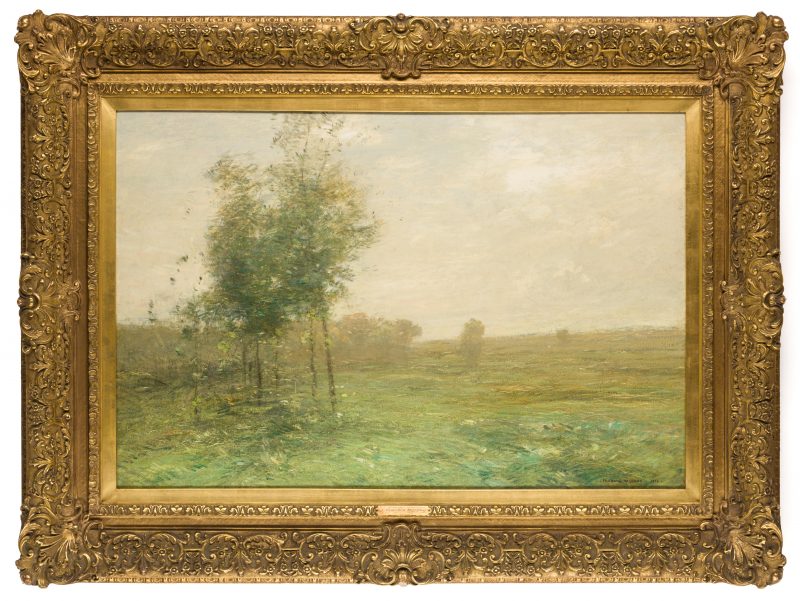 |
|
John Francis Murphy (New York/Illinois 1853-1921) large landscape oil. More information in the coming weeks. |
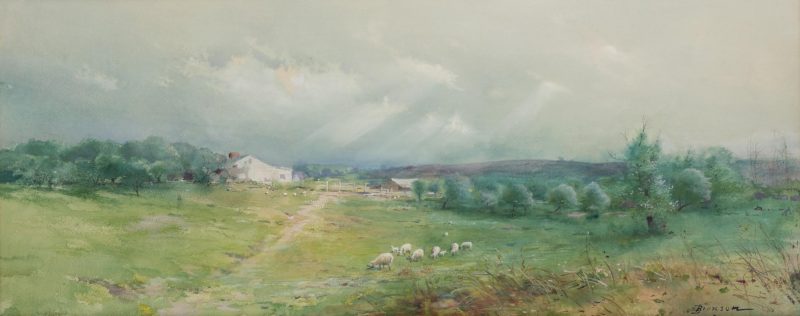 |
|
Lloyd Branson (Tennessee, 1861-1925) panoramic landscape watercolor depicting light breaking through a clouded sky on a farm house and barn with sheep grazing in the pasture. More information in the coming weeks. |
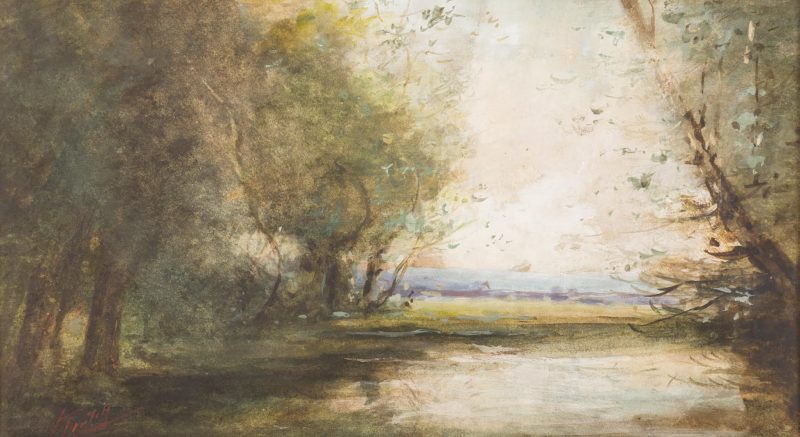 |
|
Charles Krutch (Tennessee, 1849-1934) watercolor of an East Tennessee river scene. Signed “Krutch” in red lower left corner. Knoxville estate. More information in the coming weeks. |
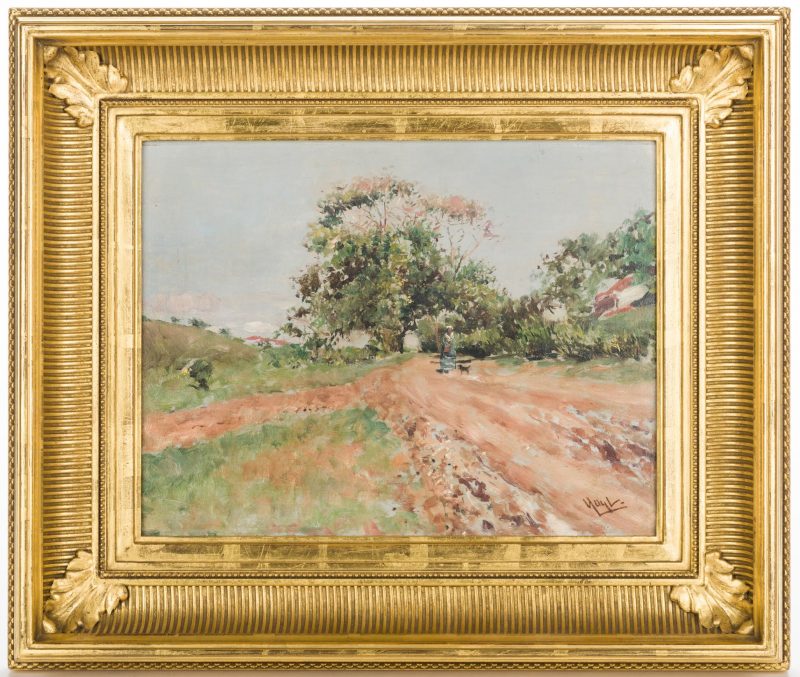 |
|
Gilbert Gaul (New York/Tennessee/New Jersey, 1855-1919) oil on board landscape painting titled in pencil en verso SOUTH NASH, depicting a country road with a female figure and a small dog standing at a crossroads. Signed GAUL, lower right. Artist name and painting dimensions with possible exhibition number 185, also en verso. Housed in a contemporary 22k gold leaf fluted cove molded frame with carved corner ornaments. Sight – 11 3/4″ H x 15 3/8″ W. Framed – 19 3/4″ H x 23 1/4″ W. Circa 1895. Provenance: Private Middle Tennessee collection. |
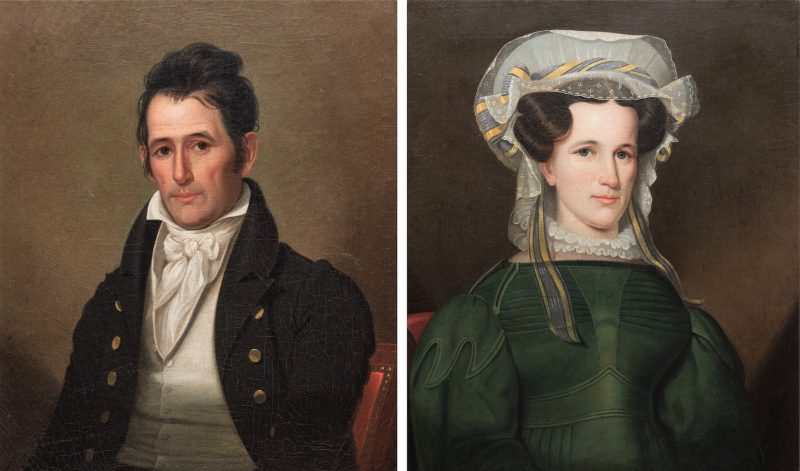 |
|
Pair of Tennessee portraits by Ralph Eleaser Whiteside Earl (1788-1838), unsigned, oil on canvas, depicting Thomas Claiborne Jr. (1780-1856) in white linen shirt with tie, waistcoat and brass buttoned coat and a woman, likely his wife Sarah Louis King Claiborne (1786-1867); in lace bonnet with yellow and purple ribbon and emerald green dress. Both housed in possibly original matching 19th century gilt wood and composition slope-molding frames with corner leaf and scroll decoration, European, one with original framer’s label verso. Both portraits measure: Sight – 29 1/2″ H x 24 1/2″ W. Framed – 42″ H x 37″ W. Circa 1830. Thomas A. Claiborne, Jr., the son of a prominent Nashville politician, would, in his own right, become an important figure in Tennessee and national politics. In 1801, Thomas Claiborne married Sarah Lewis (b. 1786 Surry County, North Carolina) in Davidson County, Tennessee. He became a successful lawyer in Nashville and subsequently ran for and served in the Tennessee House of Representatives for two terms, 1811-1815 and 1831-1833. He became a U.S. Representative to Congress for Tennessee 1817-1819. Biography (Courtesy of James C. Kelly, Virginia Historical Society, Tennessee Encyclopedia of History and Culture, 1998): Ralph E. W. Earl was the son of Connecticut painter Ralph Earl (1751-1801). Earl studied under his father in Northhampton, Massachusetts, before traveling to London in 1809 to study under Benjamin West and John Trumbull. In 1817, Earl arrived in Nashville to paint General Andrew Jackson, the hero of the battle of New Orleans. Later that year, in Natchez, he met and married Jane Caffrey, Rachel Jackson’s niece. She died the next year, but Earl moved into the Hermitage would from then on remain in Jackson’s circle, accompanying the newly elected president to Washington. During the next eight years, Earl turned out numerous paintings of Jackson. Politicians, especially Democrats, knew it “did not hurt to order a portrait of General Jackson from Earl.” He painted many of Jackson’s friends and a few of his foes. Earl returned to the Hermitage with Jackson in 1837 and died there in September 1838. Thomas Claiborne was also the first Grand Mason of Tennessee, elected in 1813. Published in the [Tennessee Historical Quarterly: Portrait Painting in Tennessee], Vol XLVI, Winter 1987, number 4. Provenance: Property of a Maryville, TN collection, previously collection of Dr. Benjamin and Gertrude Caldwell. |
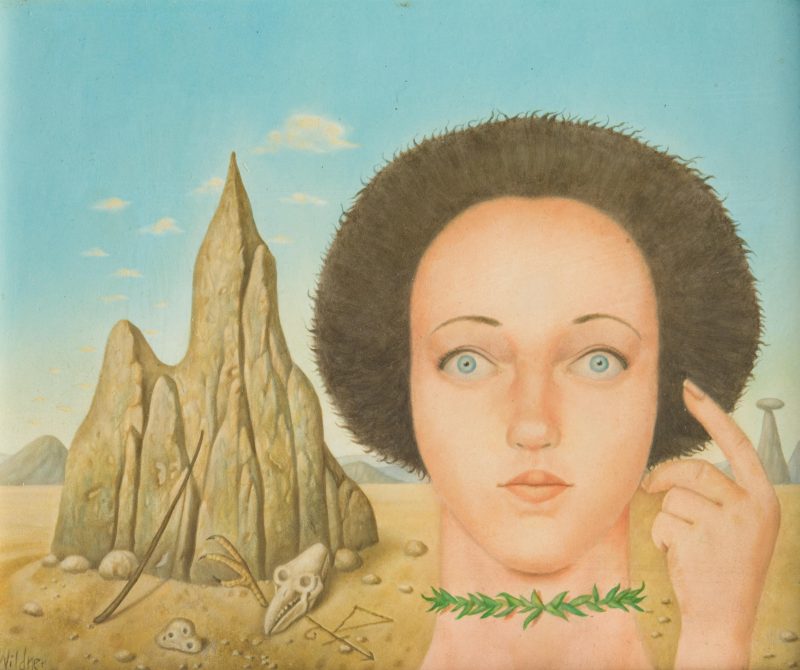 |
|
Werner Wildner (Tennessee, 1925-2004) tempera on panel depicting a female head and hand with a surrealist landscape in the background. Estate Dr. Benjamin H. Caldwell, Nashville, TN. More information in the coming weeks. |
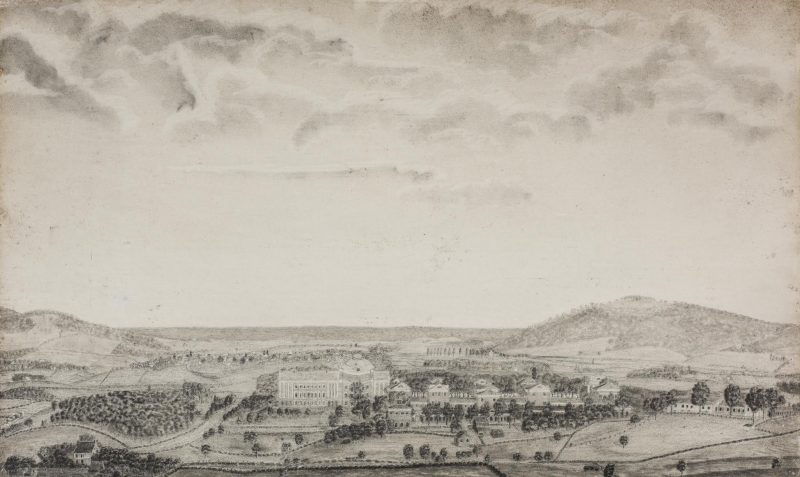 |
|
19th century bird’s eye view of the Charlottesville, Virginia area, graphite on cardstock, titled on two separate caption strips in faint period hand-written pencil script: THE UNIVERSITY OF VIRGINIA / CHARLOTTESVILLE AND MONTICELLO IN THE BACKGROUND / TAKEN FROM LEWIS MOUNTAIN. (Sketch and caption strips are laid on backing, not glued). Unsigned but possibly related to Edward Sachse, whose firm Sachse & Co. published three Virginia related lithographs: Richmond, VA (1851), Norfolk, VA (1851), and Alexandria, VA (1854) and an 1856 UVA lithograph. Housed in the original carved gilt wood frame; framing materials include square nails. Sketch – 11″ H x 18″ W. Sight – 11 7/8″ H x 17 7/8″ W. Framed – 15 1/4″ H x 21″ W. |
|
|
|
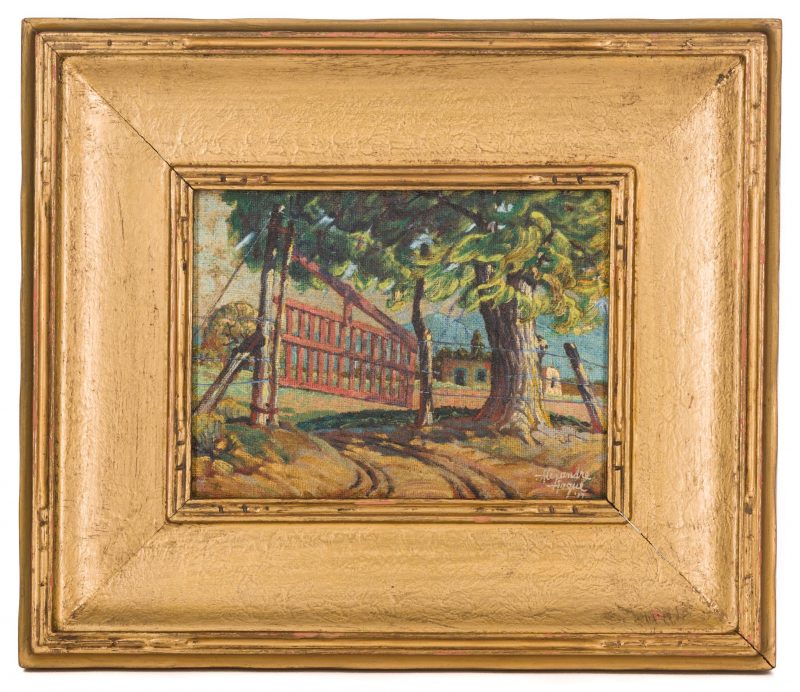 |
|
Alexandre Hogue (OK, TX, MO, 1898-1994) oil on board landscape of fence with red gate and large tree with pueblo in right background. Signed and dated “Alexandre Hogue ’27 ” lower right. Verso – “The Gate – Taos’ October 1927 Alexandre Hogue 912 Moreland Dallas, Texas”. Board – 6″ x 8″, framed 11 3/4″ x 13 1/2″. More information in the coming weeks. |
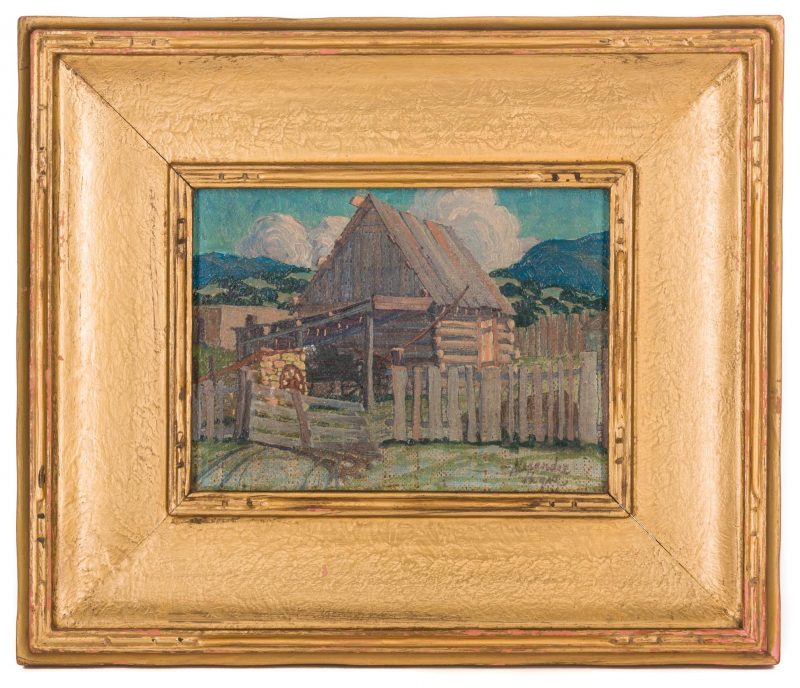 |
|
Alexandre Hogue (OK, TX, MO, 1898-1994) oil on artist’s board landscape painting titled “Mexican Barn Las Vegas”. Depicts a fenced farmstead scene of a wooden barn, a small stone structure, wheeled farm equpment and a stucco building at left background with rolling hills and white clouds in blue skies in background. Signed and dated “Alexandre Hogue 1926” lower right. Titled, signed, and dated with artist’s location “912 Moreland St. Dallas, Texas.” en verso. Housed in original gilded Art and Crafts 2-3/4″ W frame. Board – 5 7/8″ H x 8″ W. Framed – 11 1/2″ H x 13 1/2″ W. American, early 20th century. |
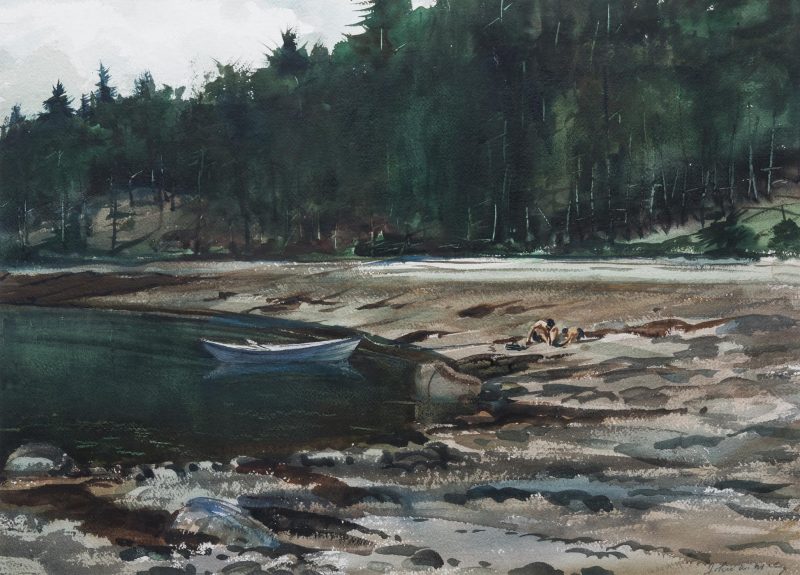 |
|
John McCoy (Pennsylvania, 1910-1989) watercolor depicting clam diggers on the shoreline of Port Clyde, Maine. Sight – 20 1/2 x 28 1/4″, framed – 32 3/4 x 40 1/2″. Chattanooga, TN collection. |
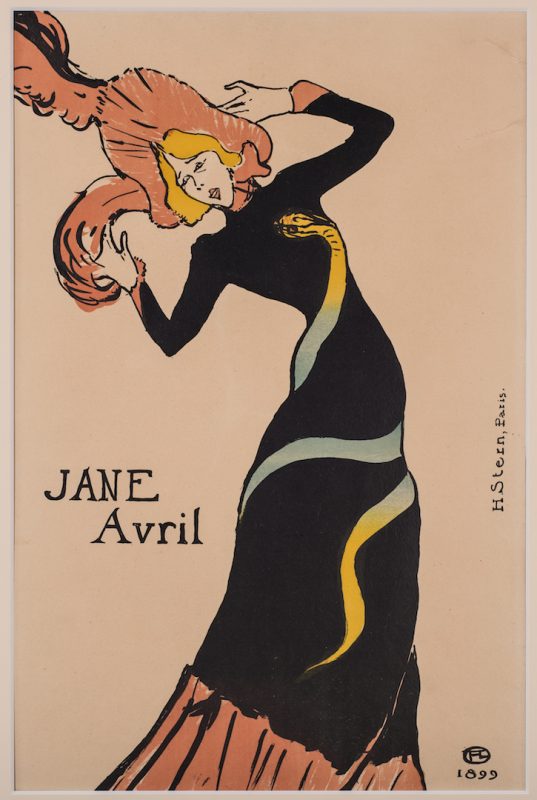 |
|
Henri de Toulouse-Lautrec (1864-1901), JANE AVRIL, 1899, original brush lithograph poster printed in four colors (from three stones) on wove paper, printed by H. Stern, Paris. Titled, dated and monogrammed in the stone. Depicts the famous Moulin Rouge dancer with a snake coiled around her dress; it was the final poster commissioned by Avril. Third state. Sheet – 563 mm x 381 mm (22 3/16″ x 15″). Frame – 828.67 mm x 635 mm (32-5/8″ x 25″). Ref. Wittrock P-29B, Delteil 367 II , Adriani 360 III. Note: “Jane Avril” was used as the cover image for the 2014 book accompanying the recent exhibit at New York’s Museum of Modern Art: “The Paris of Toulouse Lautrec: Prints and Posters from the Museum of Modern Art” by Sarah Suzuki. Provenance: From the collection of the late Dan Evins, co-founder of the Cracker Barrel Restaurant chain. |
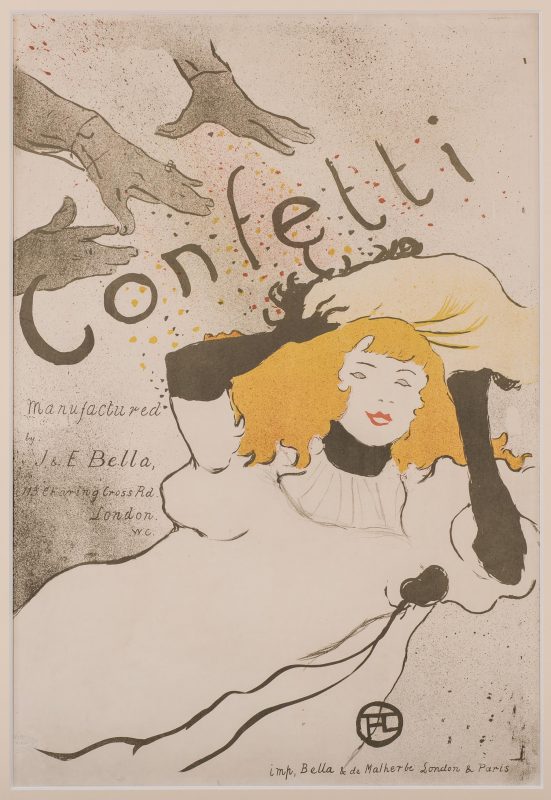 |
|
Henri de Toulouse-Lautrec (1864-1901), CONFETTI, 1894, original brush, spatter and crayon lithograph, printed in three colors on wove paper with the Kleinmann blindstamp, printed by Bella & de Malherbe, London and Paris. Note: The poster was commissioned by Bella & de Malherbe “to advertise the flecks of paper they sold to replace plaster confetti which, considered too dangerous, had finally been outlawed in Paris in 1892” (“Toulouse Lautrec, A Life” by Julia Frey, p. 385). Sheet – 570 mm x 445 mm (22-3/8″ x 17-5/8″), Image – 570 mm x 390 mm. Frame – 833 mm x 637 mm (32-5/8″ x 25-1/8″). Ref. Wittrock P-13, first and only state. Provenance: From the collection of the late Dan Evins, co-founder of the Cracker Barrel Restaurant chain. |
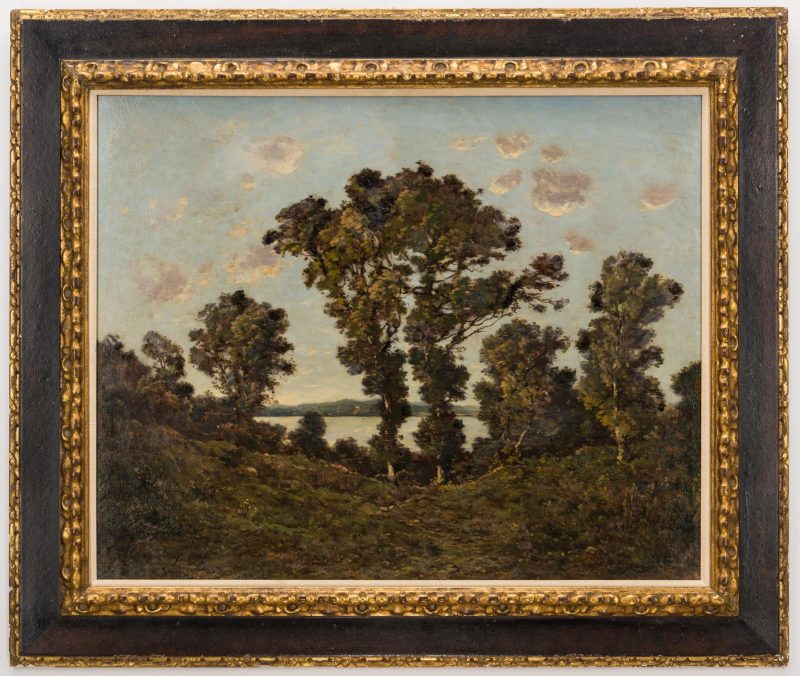 |
|
Large oil on canvas landscape by Henri Joseph Harpignies (French, 1819-1916). More information in the coming weeks. |
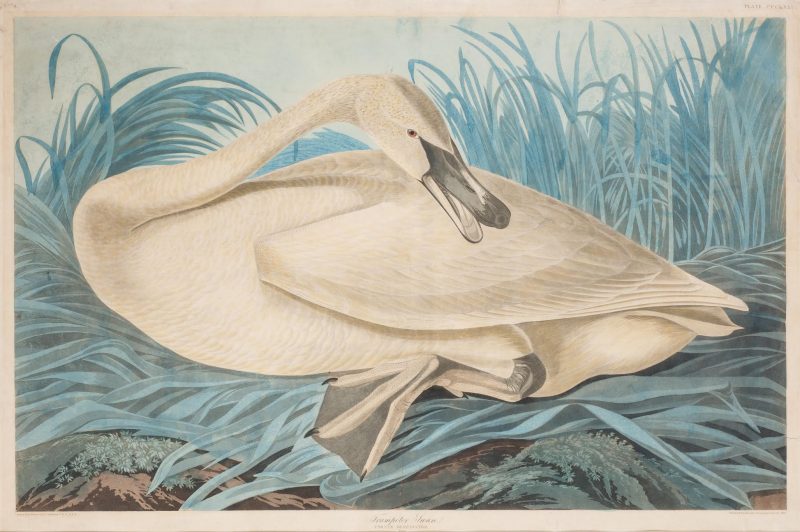 |
|
John James Audubon (1785 – 1851) hand-colored aquatint engraving with etching on wove paper, “Trumpeter Swan”. More information in the coming weeks. |
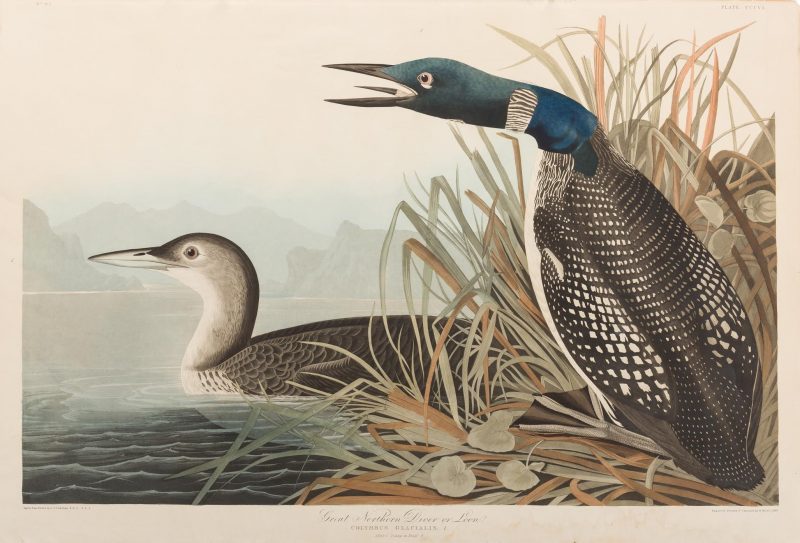 |
|
John James Audubon (1785 – 1851) hand-colored aquatint engraving with etching on wove paper, “Great Northern Diver or Loon”, plate # 62. Robert Havell and Son, engravers, circa 1838. J. Whatman Turkey Mill watermark lower right edge. 25 3/8″ x 37 1/2″ sheet size. Later stained wood molded frame, 29 3/4 x 41 1/2″. Collection of Dr. Benjamin and Gertrude S. Caldwell, Nashville, TN. More information in the coming weeks. |
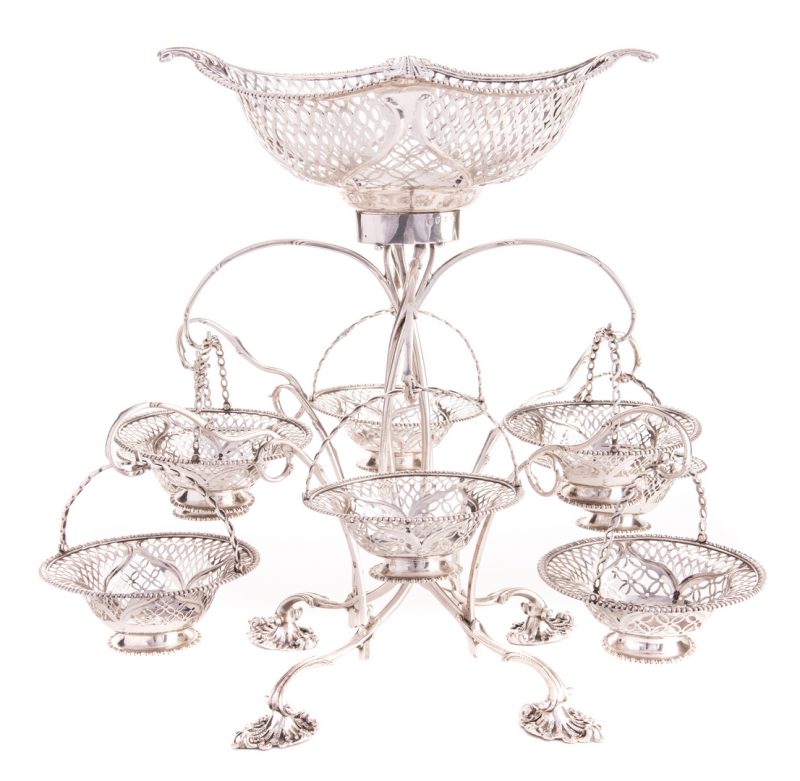 |
|
George III sterling silver epergne with hallmarks for John Kentember, London, 1769. More information in the coming weeks. |
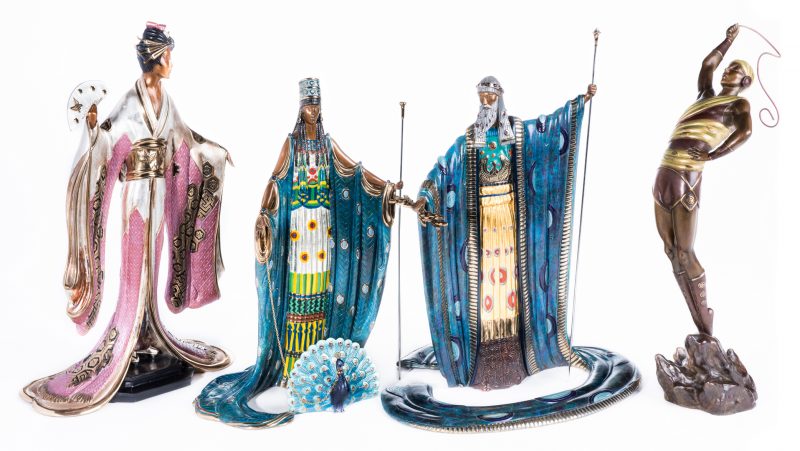 |
|
A sampling of Erte (Romain De Tirtoff, Russian/French, 1892-1990) bronzes. More information in the coming weeks. |
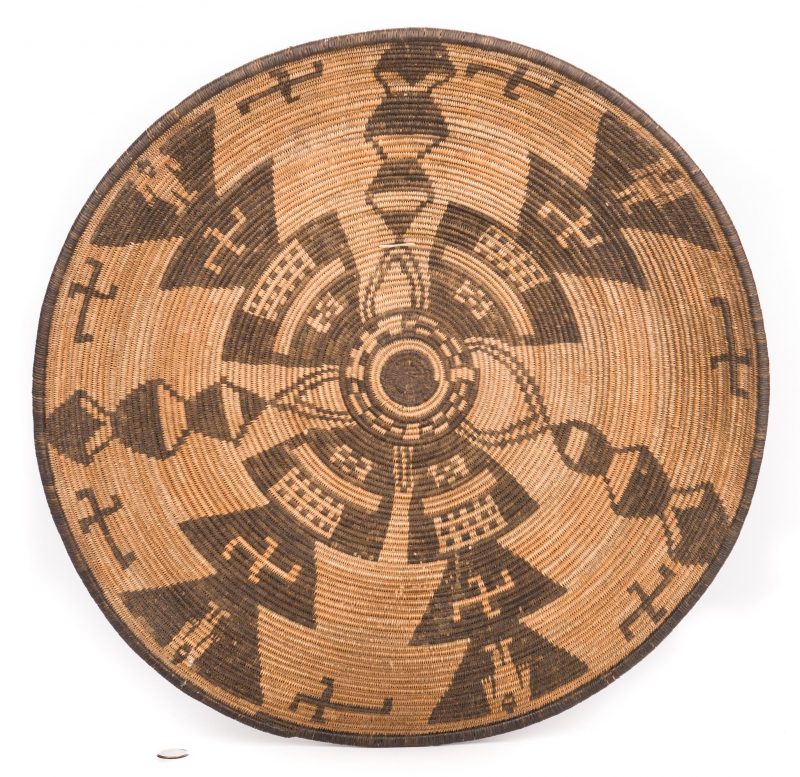 |
|
Large Native American Apache polychrome figural tray basket, coiled willow and devils claw construction with geometric designs radiating from the center with anthropomorphic figure and cross designs around the rim and additional cross designs to the center body. 21 3/4″ dia x 4″H. Early 20th century. |
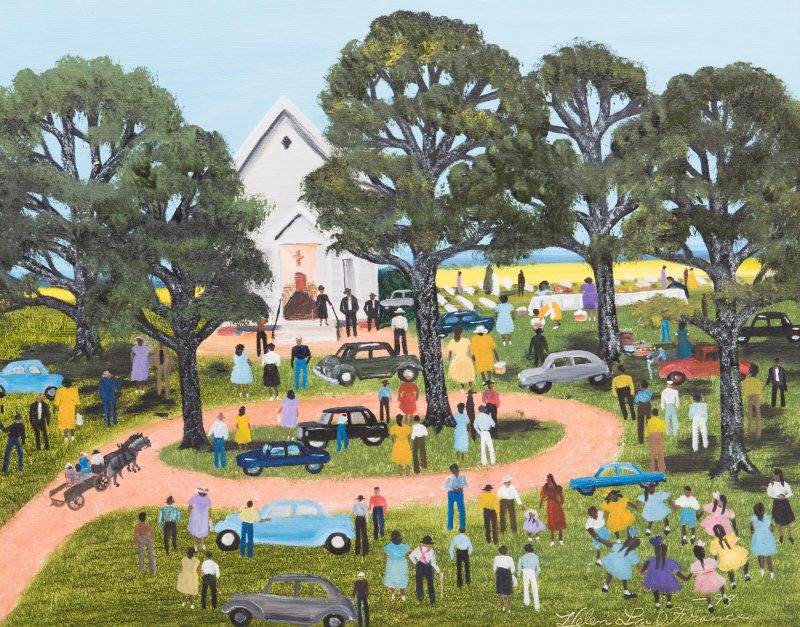 |
|
Helen LaFrance (Kentucky, born 1919) oil on canvas painting depicting parishioners at an outdoor African-American country church. Signed and dated “-98″, lower right. Housed in a gilded contemporary frame. Sight – 15″ H x 19″ W. Framed – 24 1/2″ H x 28 1/2” W. American, late 20th century. |
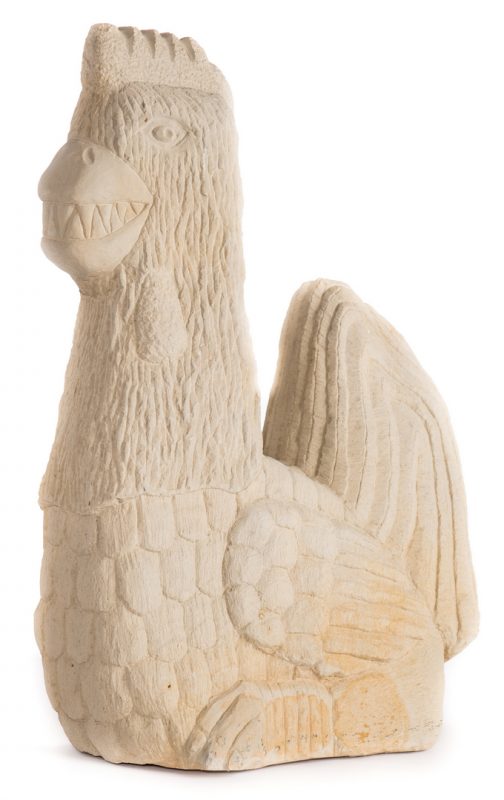 |
|
Tim Lewis (Kentucky, b. 1952) folk art carved sandstone sculpture depicting a standing rooster with open beak, baring teeth. Signed and dated, “T Lewis ’04”, beneath the tail. 23″ H x 17″ W x 6″ D. |
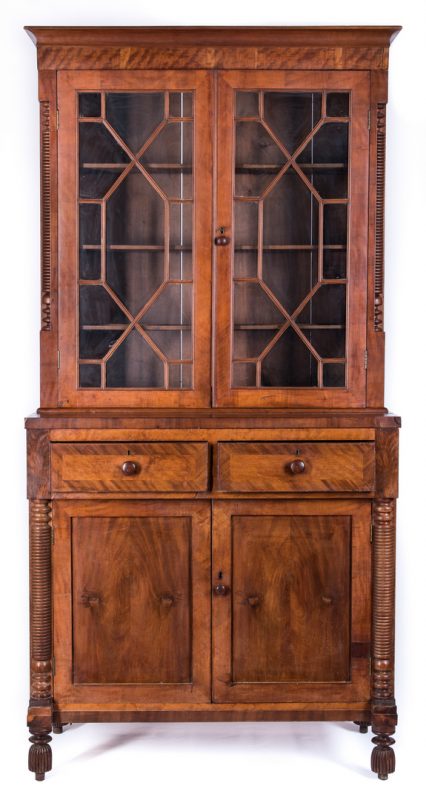 |
|
East Tennessee cherry press with figured veneers, descended through the Pace family of Greene County. More information in the coming weeks. |
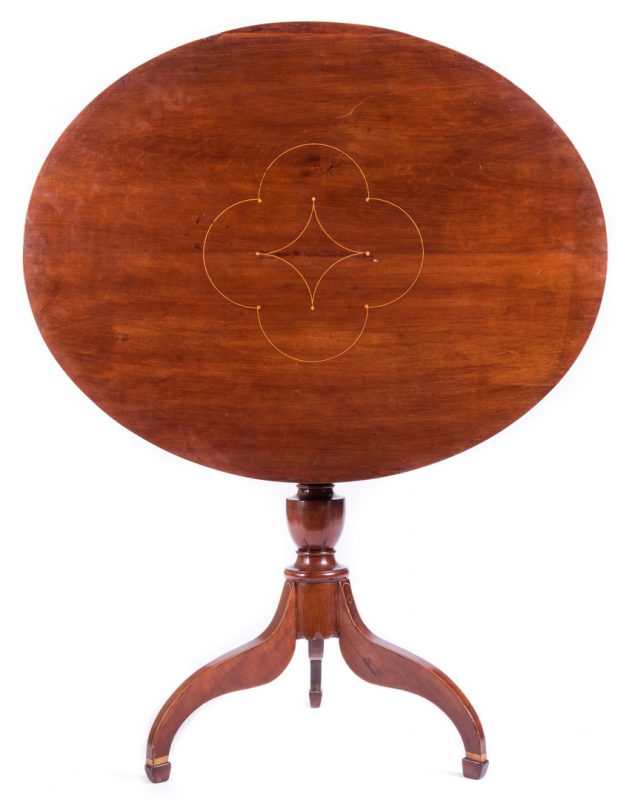 |
|
East Tennessee inlaid tea table, Overall estate, Greene County. More information in the coming weeks. |
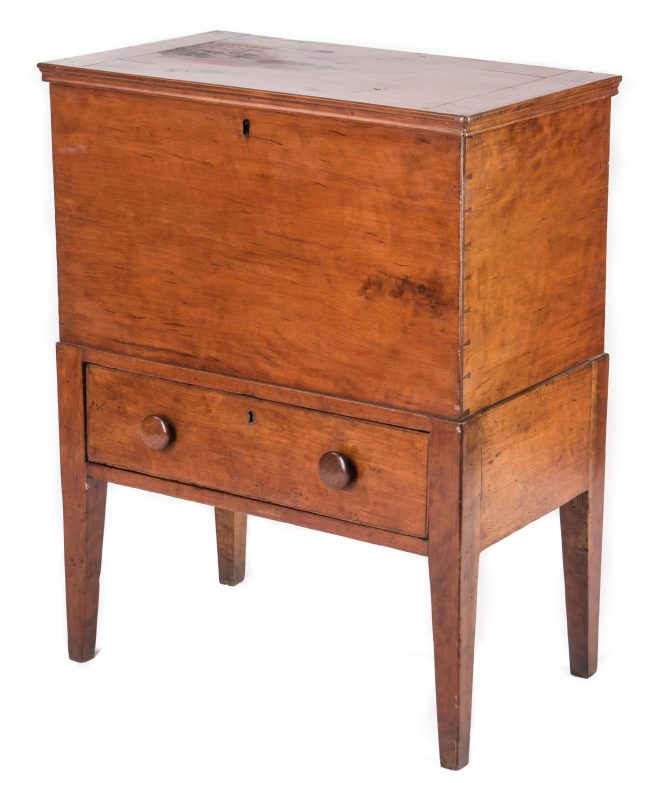 |
|
Early Williamson County, Tennessee cherry sugar chest in the Hepplewhite style with interior dividers having three sections, lower case with scratch beaded dovetailed drawer, case resting on tapered feet. Provenance: Descended in the Buchanan family of Rosemount Plantation, Williamson County, Tennessee. Illustrated in “Williamson County – More Than a Good Place to Live” by Rick Warwick. More information in the coming weeks. |
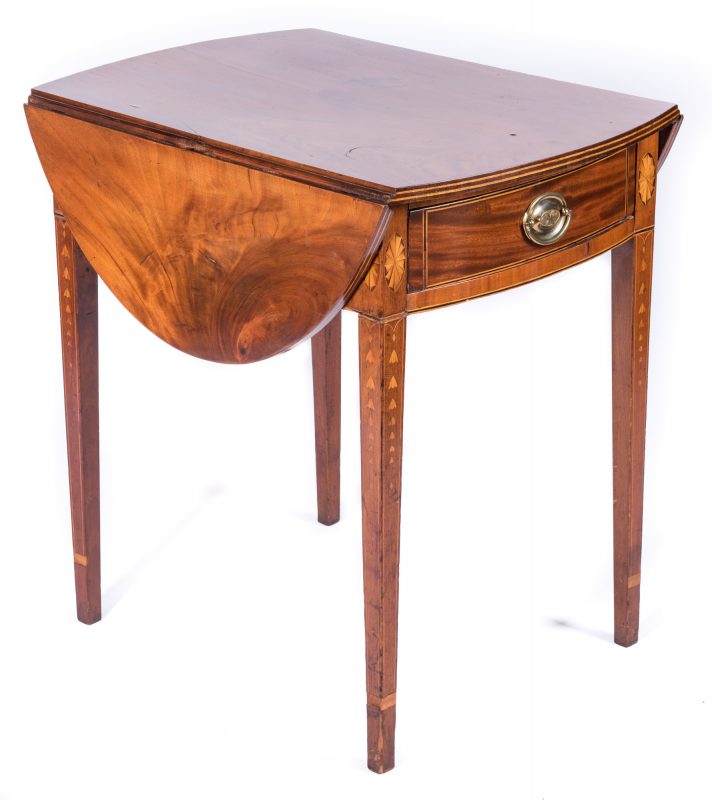 |
|
Federal inlaid mahogany Pembroke table, poplar secondary. Oval top with two drop leaves, all with double line inlaid edges, convex skirt with dovetailed drawer on one side and false drawer on the other, both outlined with ebonized and contrasting lighter wood string inlay, flanked by inlaid paterae, over square tapered Hepplewhite legs with inlaid bellflowers, line inlay and cross banded cuffs. Oval brasses. Open – 29″ x 39 1/2″ x 29″, closed – 29″ x 20 1/2″ x 29″. American, possibly Baltimore, circa 1810. Provenance: Living Estate of John and Donna Rogers, Greeneville, TN. |
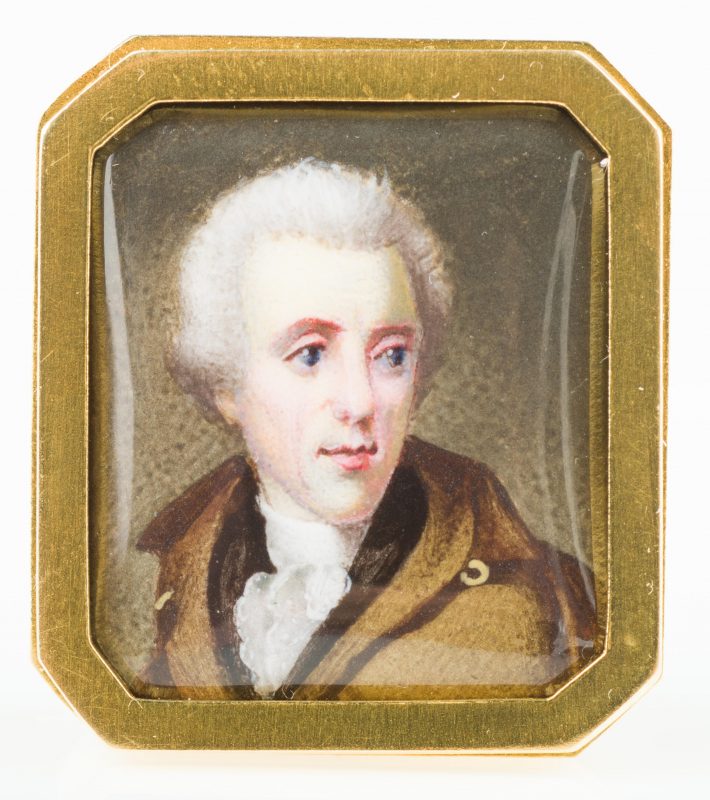 |
|
Portrait miniature of Andrew Jackson, probably from the Jackson presidential campaign.Estate Dr. Benjamin H. Caldwell, Nashville, TN. This is one of a number of pieces of Andrew Jackson related memorabilia in the auction. More information in the coming weeks. |
|
|
Early Andrew Jackson signed letter to Richard K. Call, protege and former military aide to Jackson during the War of 1812, later Governor of Florida Territory. Written from The Hermitage, Tennessee, dated January 4, 1821, prior to his appointment as Military Governor of Florida and Presidency, two and one half page letter signed Andrew Jackson, lower right of second page, with postscript initialed A. J., middle right of third page. The letter refers primarily to Call’s romantic relationship with his future wife Mary Letitia Kirkman, Nashville, TN, despite the fact that her parents were enemies of Jackson and deeply opposed the union. The postscript refers to Jackson’s approval of John C. Calhoun’s, Secretary of War, proposal for what would become the Reduction Act, passed by Congress March 2, 1821, as well as his opinions on the Missouri Compromise controversy, stating “The house of Representatives has rejected Misouri [sic], the Senate has admitted it, [John Henry] Eaton, (United States Senator from Tennessee and friend of Jackson’s), has done himself musch credit by an amendment which is said produced the admission by the Senate Should the house reconsider its vote Misouri [sic] will I expect sequester the property of the U.S. and hold it for their own use, untill [sic] it is invited into the Union by Congress, this is the only course she can adopt as an independant [sic] State, unless she returns to her Teritorial [sic] government, this would be a course too humble for a free people to submit to…”. Includes typed transcription of letter. Also includes a stipple engraving of Andrew Jackson by Henry Bryan Hall after a portrait by Ralph Eleaser Whiteside Earl (American, c. 1785/88-1838). Letter, transcription, and engraving housed in an archival letter box with marbled paper boards, black leather half-binding with gilt title lettering and five raised hubs on spine. Letter – 9 7/8″ H x 8″ W. Transcription – 11″ H x 8 1/2″ W. Engraving – 8 5/8″ H x 5 3/4″ W. Archival Box – 11 3/4″ H x 9 1/2″ W x 1 1/8″ D. American, early 19th century. Provenance: Anne P. and Thomas A. Gray Library and MESDA Research Center. |
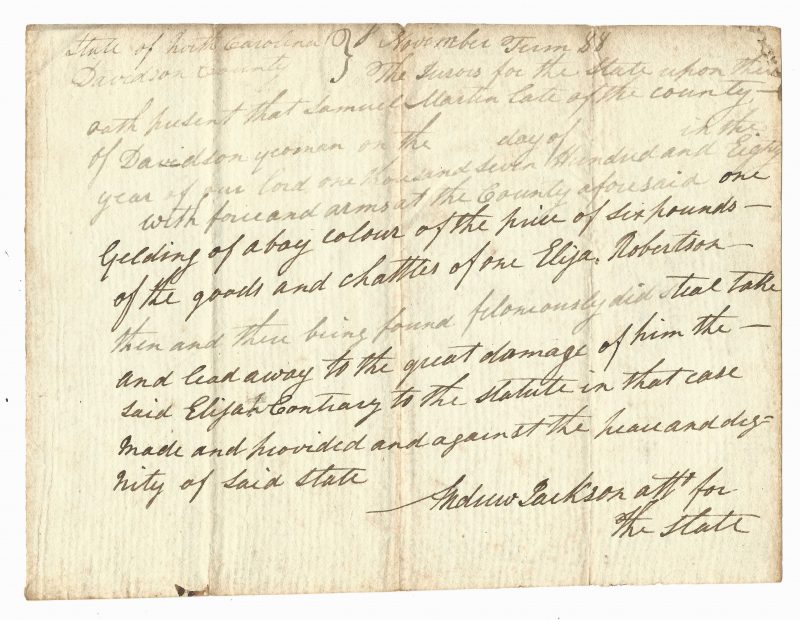 |
|
Very early President Andrew Jackson signed document, dated November 8, 1788 (the same year Jackson moved to Nashville). Written while he was serving as a prosecuting attorney for North Carolina in Davidson County, in what would later become the state Tennessee. Document reads: “The jurors for the state upon their oath present that Samuel Martin late of the county of Davidson yeoman…the year of our Lord one thousand seven hundred and eighty with force and arms at the County aforesaid on Gelding of a bay colour of one Elija Robertson then and there being found feloneously did steal take and lead away to the great damage of him the said Elijah contrary to the statute in that case made and provided an against the … and dignity of said state.” Signed lower right “Andrew Jackson, att. for the state”. Docketing en verso also written by and signed by Jackson. 6 1/4″ H x 8 1/4″ W. |
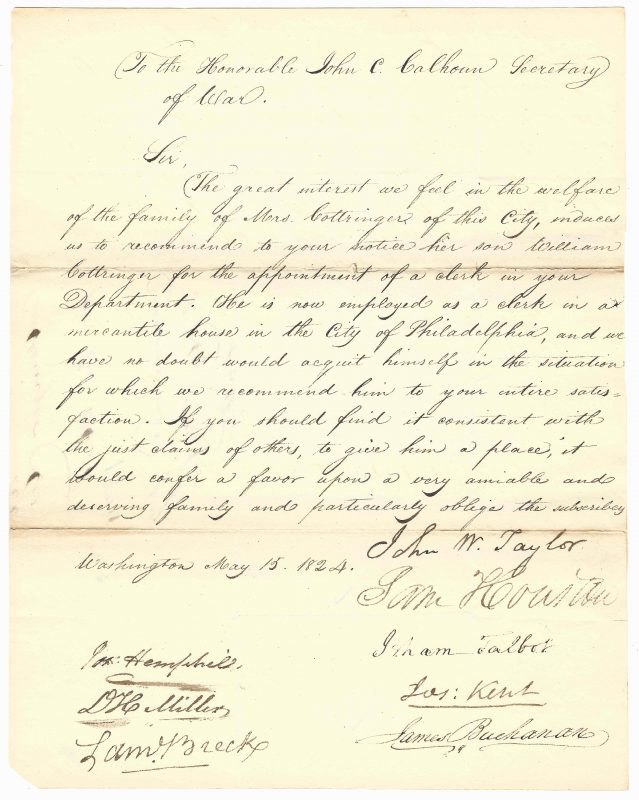 |
|
Sam Houston and James Buchanan signed letter addressed to Secretary of War, John C. Calhoun. Dated May 15, 1824 when Sam Houston served as a Tennessee congressman and James Buchanan served as a Pennsylvania congressman. |
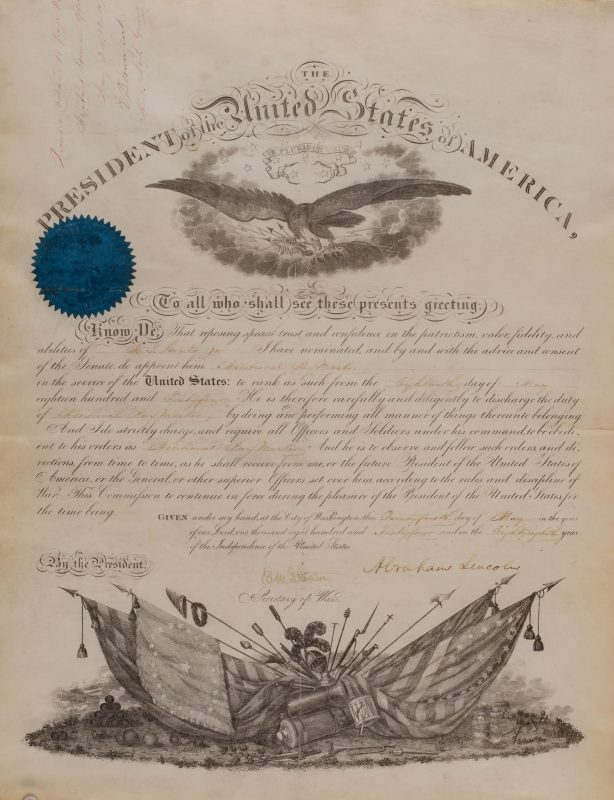 |
|
Civil War period commission document, completed in manuscript and signed by President Abraham Lincoln, appointing R.S. (or R.P.) Gould Jr. Additional Paymaster in the Union Army. Countersigned by Secretary of War Edwin Stanton. Dated May 24, 1864. Patriotic eagle and flag vignettes at top and bottom of document, blue wafer seal upper left with docketing notations of the Adjutant General’s office, signed E.D. Townsend. 18 1/8″ x 14 1/2″. Unframed. Provenance: Nashville, Tennessee area collection |
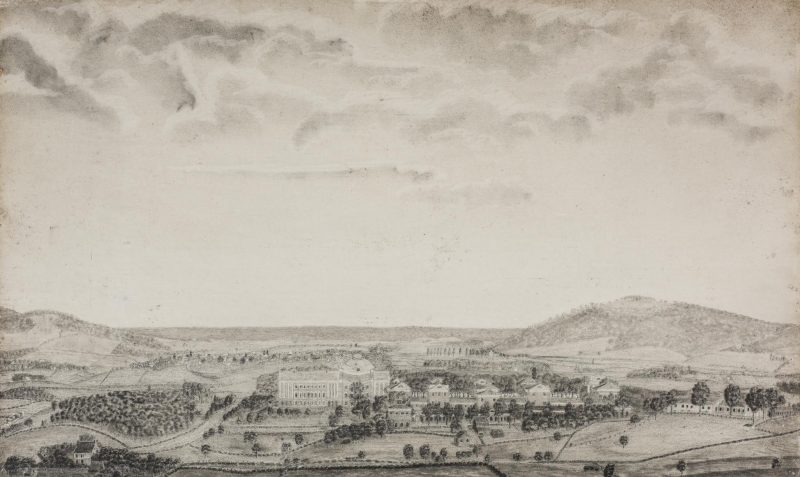 |
|
Mid 19th century charcoal panoramic drawing of the University of Virginia, Charlottesville from Lewis Mountain vantage point. More information in the coming weeks. |
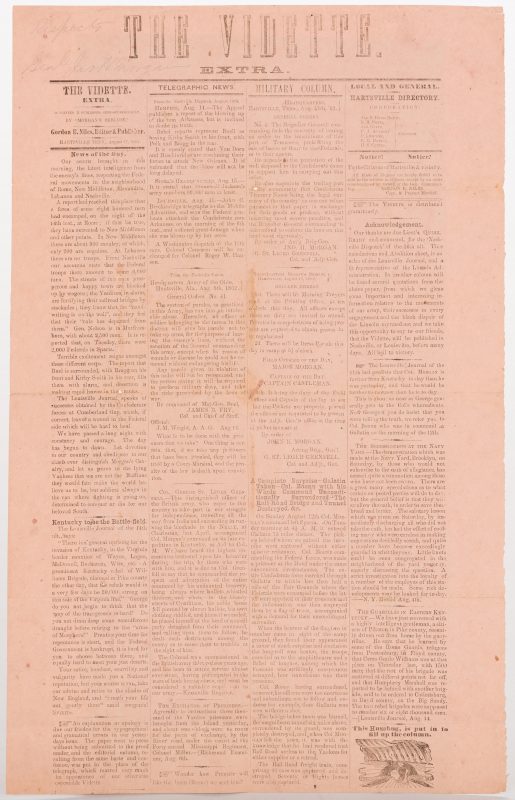 |
|
Scarce Confederate General John Hunt Morgan (1825-1864) signed one-page broadside to The Vidette, a camp newspaper of Morgan’s 2nd Kentucky Cavalry or more commonly called “John Hunt Morgan’s Brigade”. Signed boldly on the upper left corner in pencil, “Respects, Gen’l. Jno. H. Morgan”. Published Hartsville, TN, August 17, 1862 as a one-page extra on large folio pink necessity paper. Edited and published by Capt. Gordon E. Niles (d. 1862), a New York newspaperman who was a Southern sympathizer and volunteer for Morgan’s Brigade. Current Civil war content and events discussed including “News of the Day”, “Kentucky to be the Battlefield”, “Galatin Taken – Col. Boone with his whole command unconditionally surrendered” and the exploits of Col. George St. Leger Grenfell (1808-1868), a former officer with the British Army in India, Southern Sympathizer and Adjutant of Morgan’s End Kentucky Cavalry. 17 1/2″ H x 12″ W. Provenance: Originally part of the Marshall B. Coyne document and manuscript collection sold by Sotheby’s in June, 2001. Marshall B. Coyne collection stationary included with the lot. Note: The Vidette was first published in Hartsville, Tennessee and continued on an irregular basis until Morgan’s death. The first editor Captain Niles was killed shortly after this Extra publication. John Hunt Morgan was killed at Greeneville, Tennessee in September, 1864. 17 1/2″ H x 12″ W. Circa 1862. |
 |
|
Confederate Artillery two piece buttons marked, “Chatwin & Sons -Birmingham (England)”. Two piece cuff/sleeve buttons marked, “London Quality”. More information in the coming weeks. |
|
|
|
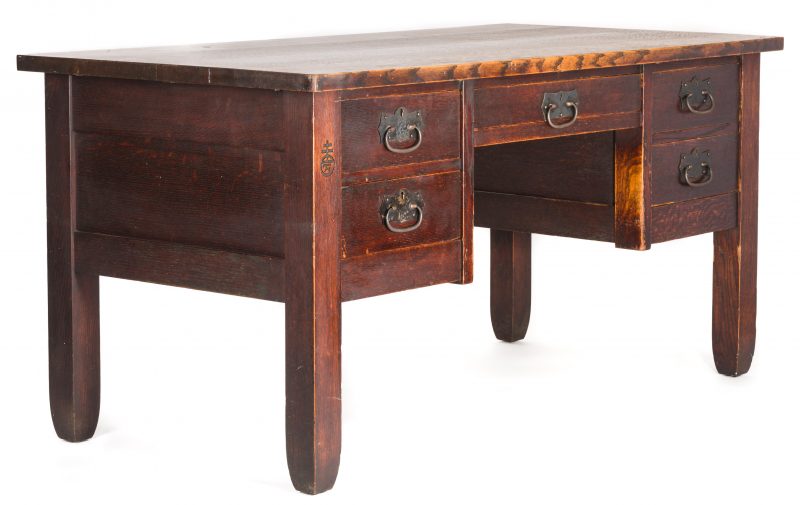 |
|
Roycroft stamped five drawer desk in an old surface, East Aurora, NY. More information in the coming weeks. |
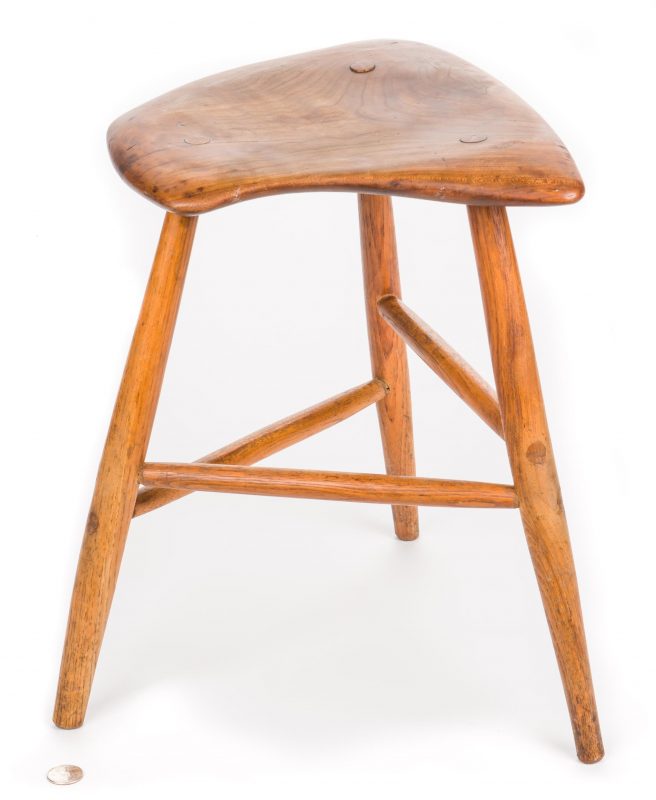 |
|
Wharton Esherick (Paoli, PA, 1887-1970) walnut and hickory three-legged stool in an older patina with sculpted seat, through tenon construction, carved under seat with initials and dated “WE 1960”. 16-1/4″ H x 13-1/4″ W x 11″ D. Knoxville, TN collection. |
 |
|
Marcus & Co. platinum and diamond line bracelet containing 34 transitional cut diamonds with a total weight of approximately 6.8 cts., (approximately VS2-SI1 clarity and H-I color). Mounting made of square links, fine milgrain detail framing each diamond and sides with Art Deco style sunburst design. Marked “Marcus 50860″ on clasp, 7” L, 19.8 grams. Circa 1925. |
 |
|
Nashville, Tennessee coin silver sugar tongs, plain fiddle handles with oval grips, marked on each arm J * E (mark attributed to John Elliston, 1809-1823, Nashville, TN). Note: John Elliston was the nephew and business partner of Joseph Thorp Elliston. He was born in Kentucky and like his uncle, apprenticed with Samuel Ayres before moving to Nashville (ref. Tennessee Silversmiths by Dr. Benjamin H. Caldwell, p. 74). Monogammed ML or MS. 6 1/4″L. Estate Dr. Benjamin H. Caldwell, Nashville, TN. |
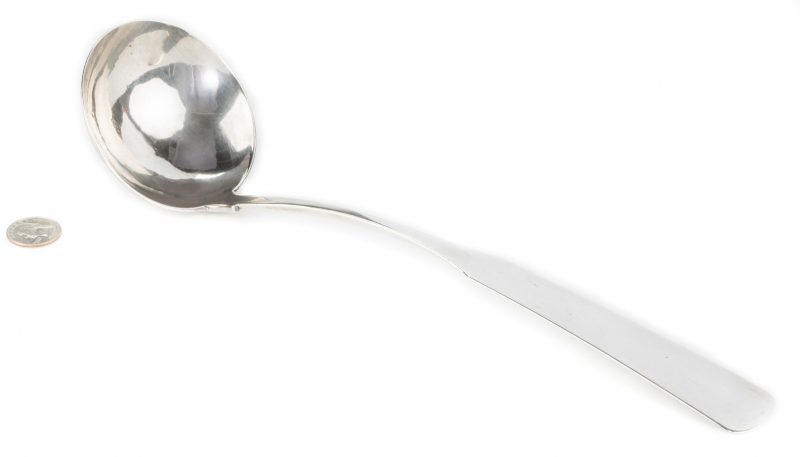 |
|
Coin silver soup or punch ladle attributed to Griffin Garner (Knoxville, TN and Fincastle, VA), round bowl and plain fiddle handle, marked on back GARNER in rectangle.Estate Dr. Benjamin H. Caldwell, Nashville, TN. More information in the coming weeks. |
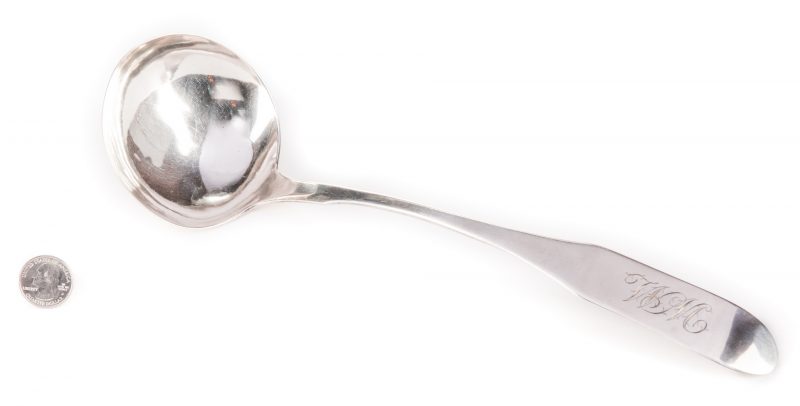 |
|
North Carolina coin silver ladle attributed to Nathaniel Vogler (Salem, NC 1804-1872). More information in the coming weeks. |
 |
|
Scarce coin silver water dipper with beaded rim and end, repousse floral decorated bowl with star on bottom and central cartouche with engraved monogram “Ella” for Ella Young McGavock (b. 1836-d. 1861). Turned ebonized handle with silver tip and hanging ring. Unmarked. Bowl – 4″ diameter. Overall length – 16″. Biography: Ella Young McGavock was born in Mississippi in 1836 to Alexander and Elizabeth Young. She married Edward Jacob McGavock of Nashville in 1857 and the couple lived at Pecan Point Plantation in Arkansas. Ella gave birth to three children, Louisa Grundy McGavock Tyner, Frank McGavock, and Ella Young McGavock Wilson, before her untimely death in 1861 at the age of 25. She is buried in Lowndes County, Mississipi. Provenance: Descended in the family of Edward Jacob McGavock to consignor. |
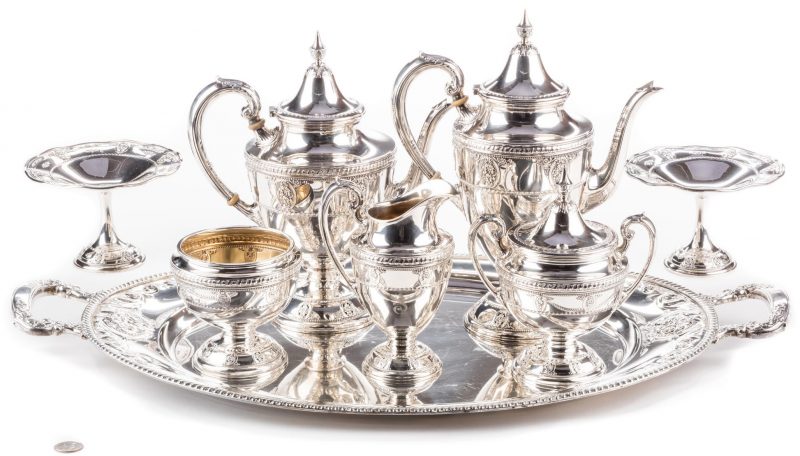 |
|
Wallace Rose Point pattern sterling silver coffee/tea service including coffee pot, tea pot, covered sugar dish, creamer, waste bowl, round footed compotes, and the sterling silver tray. |
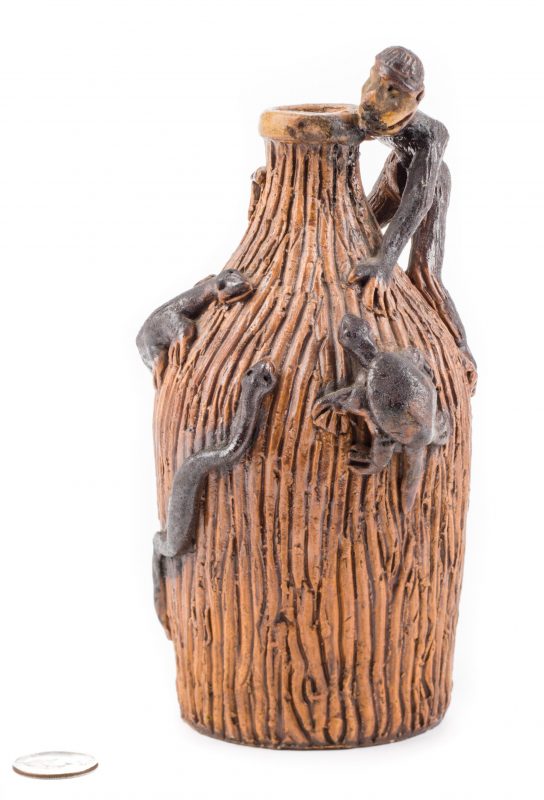 |
|
Temperance jug incised “B 1885” and incised on the underside “Bray 1885”. More information in the coming weeks. |
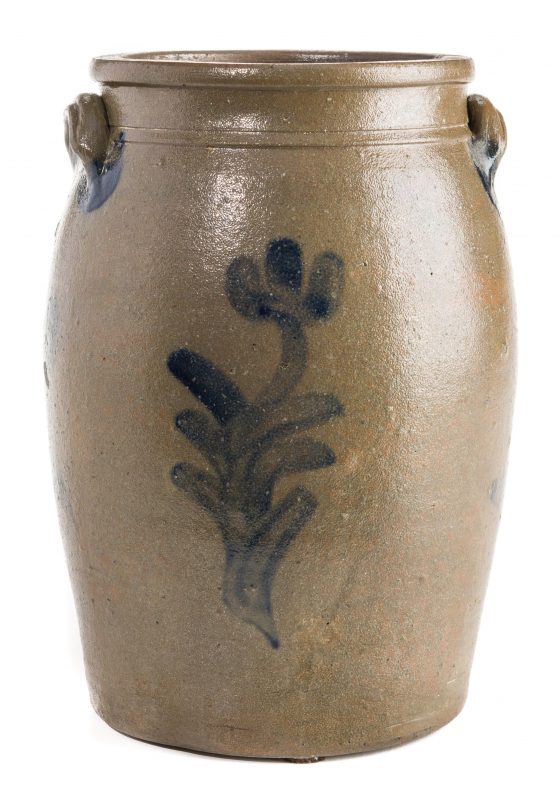 |
|
Washington County, Tennessee stoneware pottery jar attributed to Charles Frederick Decker (1832-1914) with cobalt multiple petal flower decoration to four sides, cobalt rings around the base of handles. Impressed “2” on top of jar rim denoting gallon capacity. 12 1/4″ H x 9″ dia. (at mid-section). Biography (Courtesy of Carole Wahler): Charles Frederick Decker was born in Germany in 1832. He arrived in Philadelphia in his late teens. Oral tradition suggests he worked at the Remmey Pottery before establishing his Keystone pottery there at the age of 25. He moved his family to Delaware for a few years and then back to Philadelphia. After 1869, Decker moved to Virginia, six miles north of Abingdon. The pottery he operated there was located on land owned by a man named Mallicote (Mallicoat). In 1872, he established his pottery in the Nolichucky River Valley near present day Johnson City, Tennessee. For a year or so he operated in both Virginia and Tennessee. He was one of a number of potters who settled in the region during the early years of Reconstruction. He named his Chucky Valley pottery the same name that he had used in Pennsylvania, Keystone Pottery. His pottery was marketed not only in East Tennessee, but also in North Carolina, Virginia, and Kentucky. Estate of Barbara Gipe, Kingsport, Tennessee. |
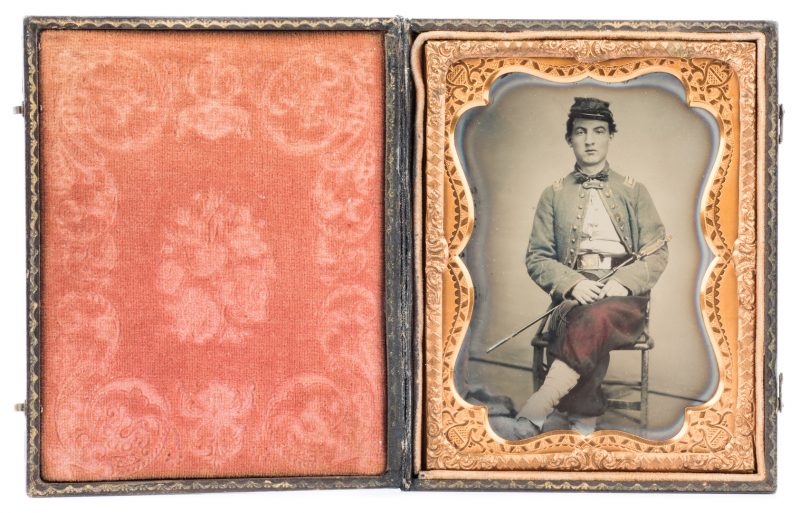 |
|
Civil War quarter plate ambrotype of an armed soldier in Zouave style uniform. More information in the coming weeks. |
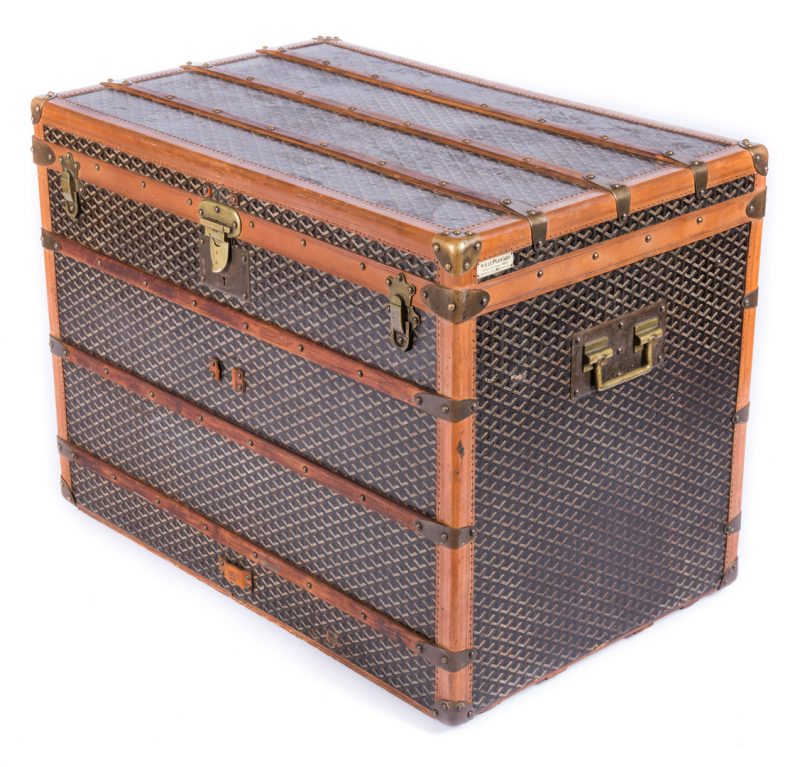 |
|
Labeled Malles Goyard, Paris trunk. More information in the coming weeks. |
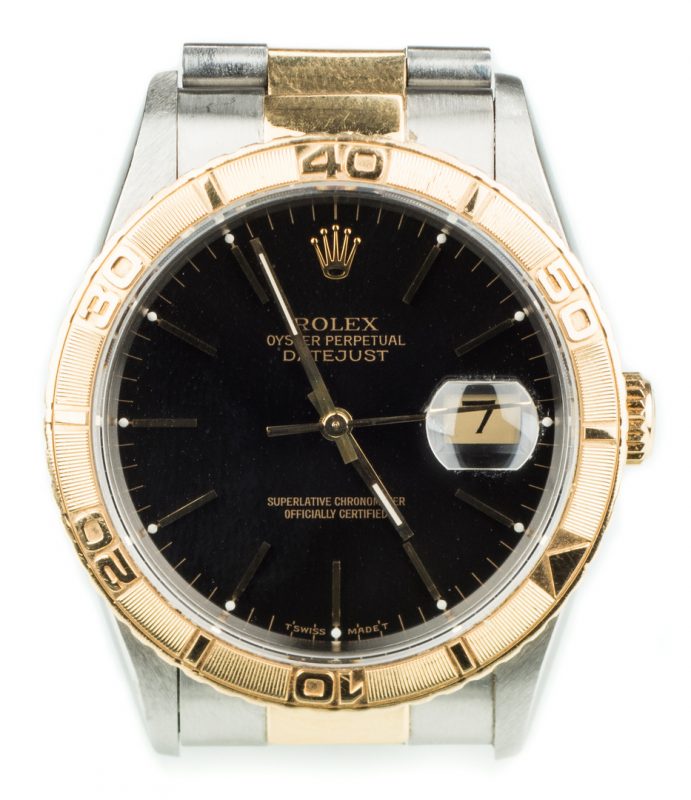 |
|
1993 Men’s Rolex Datejust Thunderbird Watch 16263, 36 mm stainless steel with 18K yellow gold case, black stick dial, date eye, Turn-O-Graph bezel, 18K and stainless steel deployment bracelet, Serial No. S828212 with original box and papers. purchased 1996, 7-inch interior circumference. Provenance: Private collection, Knoxville, TN. |
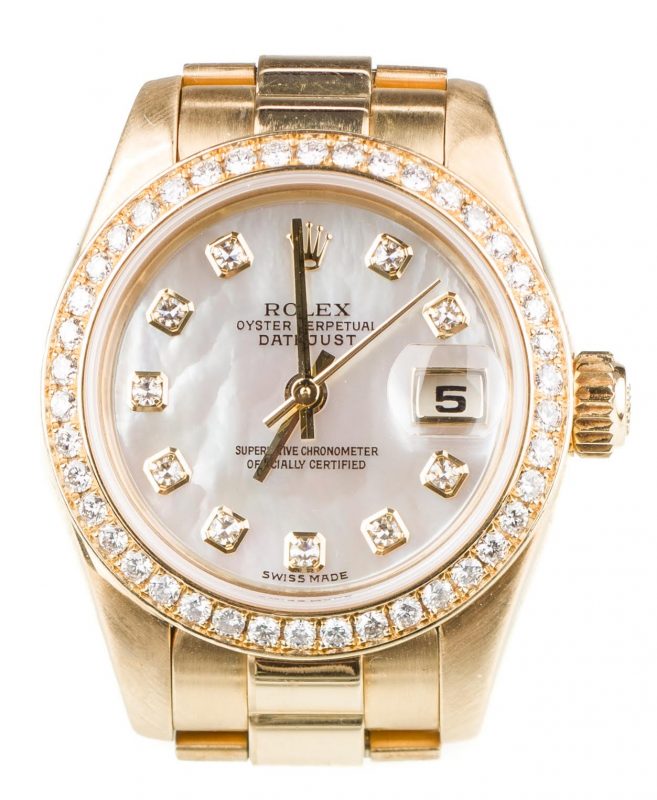 |
|
Ladies 2001 Rolex all 18K yellow gold 26mm Presidential Datejust watch, 179138, mother-of-pearl face with diamond hour markings and Rolex brand diamond bezel, 18K bracelet with clasp marked 83138. Serial #K582500. 6-5/8″ L interior opening. In working condition at time of inspection. 103.2 grams total. Provenance: Living Estate of John and Donna Rogers, Greeneville, TN. |
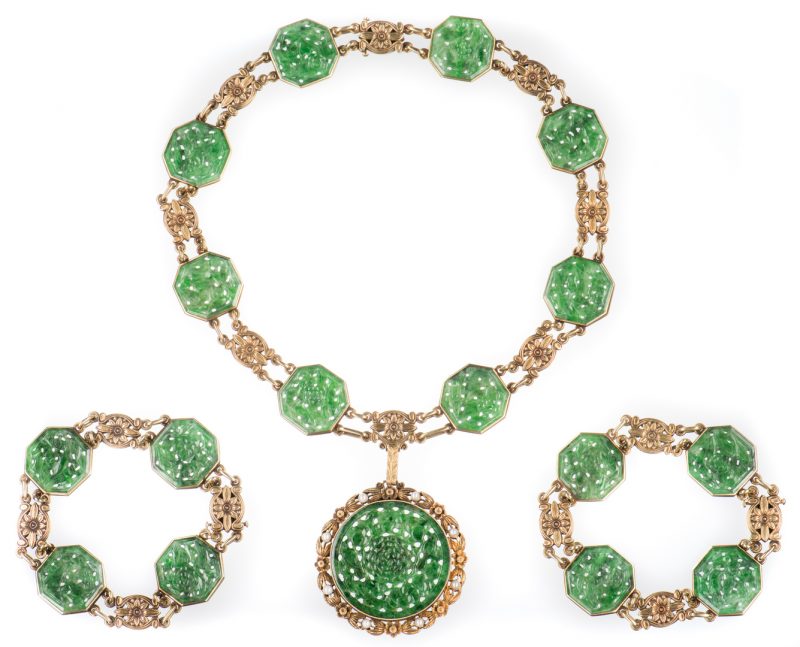 |
|
Tiffany & Co. 18K yellow gold and jadeite demi parure pendant necklace converting to a smaller necklace and two bracelets. Marked “Tiffany & Co. 18K” on back of pendant. More information in the coming weeks. |
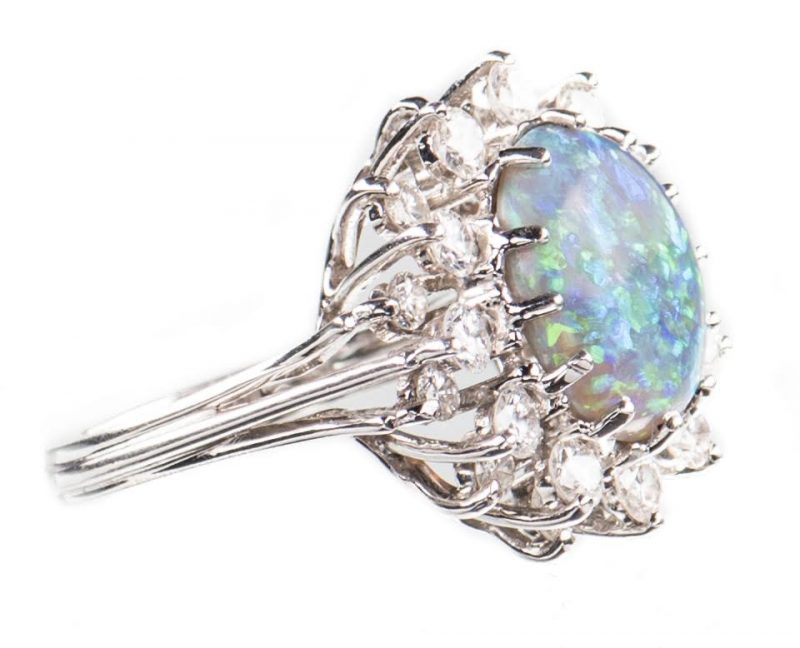 |
|
10 ct. Lightening Ridge opal and diamond dinner ring set in 14K white gold mounting. Oval black opal measuring 13 mm x 10 mm x approx. 3.7 mm and containing 12 round brilliant diamonds with a total weight of 1.20 ct and 12 round brilliant diamonds with a total weight of .84 ct. (all G, VS1). Ring size: 5 3/4. Manufacturer mark of IBG or JBG. 7.1 grams. |
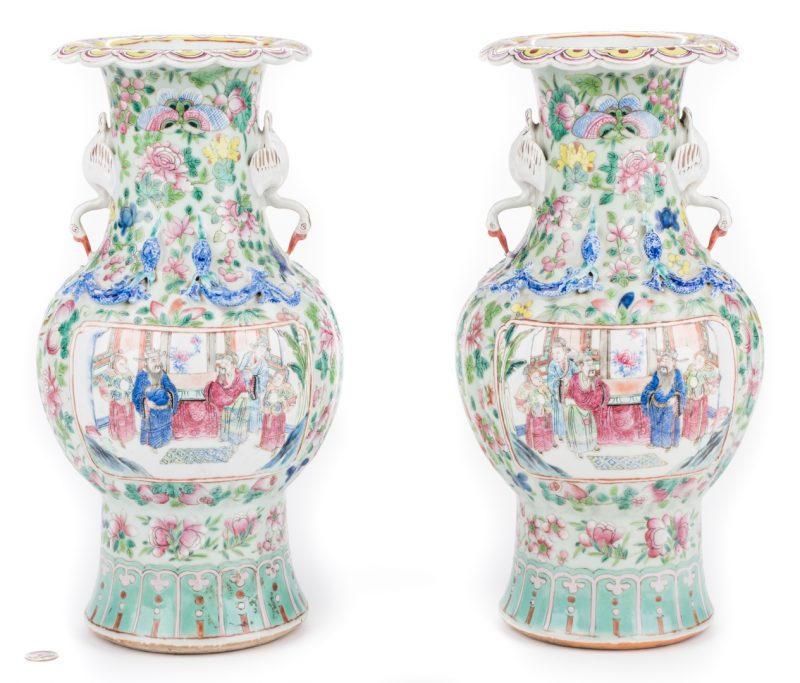 |
|
Pair Chinese Guangxu Vases. More information in the coming weeks. |
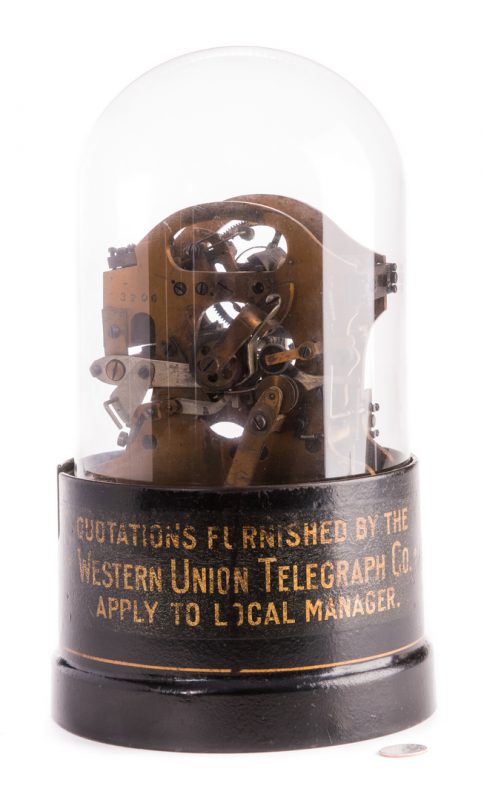 |
|
Western Union Model 35-A self-winding ticker tape machine, serial #3206, with brass frame, telegraph mechanism, twin alpha-numeric rollers and tape feed with escapement mechanism, over electro-magnet, all housed in a cast iron base with Western Union label reading “Quotations Furnished by The Western Union Telegraph Co. – Apply to Local Manager”. Retains the original glass dome. Machine measures 10 3/4″ H x 8 1/2″ dia. 13 1/2″ H w/ glass dome. Early 20th century. |
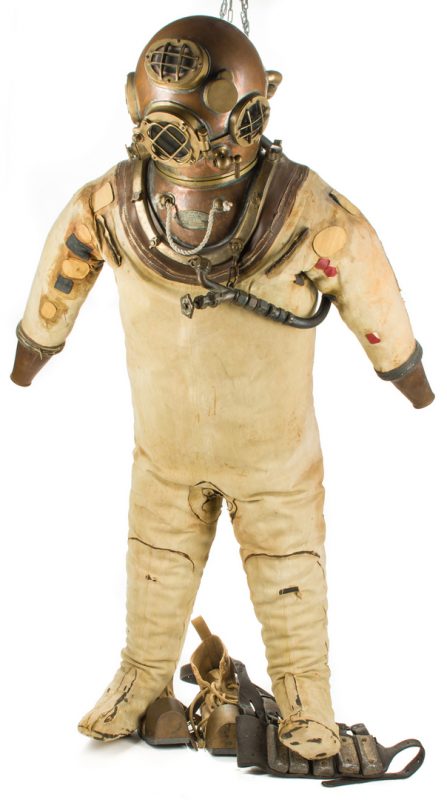 |
|
Pre-WWII Morse Diving Suit. More information in the coming weeks. |